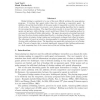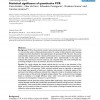44 search results - page 8 / 9 » Sampling Methods for Action Selection in Influence Diagrams |
IWANN
1999
Springer
13 years 11 months ago
1999
Springer
To avoid the curse of dimensionality, function approximators are used in reinforcement learning to learn value functions for individual states. In order to make better use of comp...
ML
2006
ACM
13 years 7 months ago
2006
ACM
Bridge bidding is considered to be one of the most difficult problems for game-playing programs. It involves four agents rather than two, including a cooperative agent. In additio...
BMCBI
2007
13 years 7 months ago
2007
Background: PCR has the potential to detect and precisely quantify specific DNA sequences, but it is not yet often used as a fully quantitative method. A number of data collection...
UAI
2000
13 years 8 months ago
2000
Stochastic games generalize Markov decision processes MDPs to a multiagent setting by allowing the state transitions to depend jointly on all player actions, and having rewards de...
ICML
2000
IEEE
14 years 8 months ago
2000
IEEE
Eligibility traces have been shown to speed reinforcement learning, to make it more robust to hidden states, and to provide a link between Monte Carlo and temporal-difference meth...


